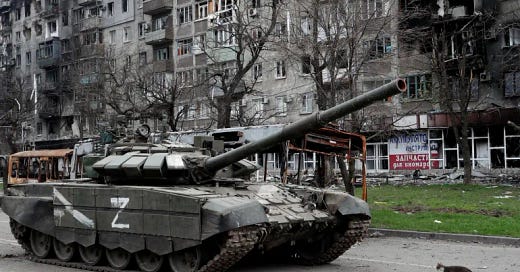Russian War Losses Pass Grim One Million Milestone
The War in Ukraine Is Turning Inward and Breaking the Kremlin
Russian casualties in Ukraine have now surpassed one million soldiers according to a recent report published in Newsweek. This grim milestone exposes weakness, blunder and strategic failure on an industrial scale. For a war that has dragged on for just over three years, this figure is not only shocking, it’s damning. To put this into perspective: the Soviet Union lost around 15,000 troops in Afghanistan over a decade. The United States lost just over 58,000 in Vietnam over eight years. In Ukraine, Russia has surpassed both these blood-soaked episodes many times over and there is precious little to show for it.
The Russian military, still enthralled by its own mythology, is relying on a century-old playbook. The “Meat wave” tactic, which involves throwing wave after wave of poorly trained, poorly equipped soldiers at fortified Ukrainian positions, might have made sense in the trenches of Verdun or on the steppes outside Stalingrad. In an era defined by satellite-guided munitions, drone swarms, and asymmetric warfare, this is not just outdated, it’s suicidal. Yet the consequences of this catastrophic military doctrine are not confined to the battlefield alone, the war is increasingly coming home to Russia.
In recent weeks, Ukraine has launched a series of audacious, high-impact strikes deep inside Russian territory. This includes yesterday’s pinpoint attack on a high-tech military facility (Rezonit technology park in Zubovo) which is supposedly central to Russia’s defence innovation. This followed last week’s audacious drone swarm attack that involved smuggling trucks full of attack drones deep into Russian territory and then activating them to eliminate one third of Russia’s strategic bomber fleet
These attacks are game-changers in that they upend the assumption that the Kremlin can fight a foreign war with impunity. They challenge the illusion of control that Putin has tried to maintain at home and they lay bare the brittleness of the Russian military-industrial complex, which is now increasingly vulnerable and stretched to its limits. The war is no longer something Russians just watch on TV, they can now watch it from their bedroom windows.
Despite years of fighting, despite enormous human and economic costs, Russia has little to show in terms of territorial gains. What limited ground has been taken has come at a devastating price and often lost again shortly after. Ukraine’s forces have shown adaptability, tenacity, and creativity, qualities that the Russian military, sclerotic, top-heavy, and addicted to outdated dogma, has consistently failed to match.
Ukraine has also succeeded in reshaping the conflict on its own terms. This is no longer just a defensive war for them, it’s strategic resistance. Their ability to strike at symbolic and strategic targets within Russia itself is more than just a tactical development. It is psychological warfare, an effort to pierce the veil of invincibility that the Kremlin has tried so desperately to project to its own people.
Internally, the Russian economy is suffering from a slow but unmistakable rot as sanctions continue to bite. Oil revenues are no longer the get-out-of-jail-free card they once were. Skilled professionals are leaving the country in droves. Inflation is persistent. Corruption, as always, is rampant and now the war is coming back to the cities and towns that were supposed to be immune from its effects.
Moscow’s hope that China might provide an economic and strategic lifeline appears increasingly delusional as recent signals suggest the relationship is strained. Beijing is wary of tying itself too tightly to a failing, increasingly toxic regime, especially one that’s being boxed in by a united Western front and now faces reputational blowback in Asia and Africa. China plays a long game and Putin is running out of moves.
Iran, another hoped-for ally, is hardly in a position to offer sustained support. Tehran is juggling its own internal chaos and international isolation, and while it has shipped drones and advisers, it can’t offset Russia’s mounting losses or provide the kind of long-term support Moscow needs to stay in the game. Russia is running out of friends, and out of time.
In all this, the role of Donald Trump cannot be ignored. His refusal to understand the conflict’s true nature, and his instinct to view it as a transactional sideshow rather than a geopolitical flashpoint, derailed any serious chance at diplomatic resolution early on. His flirtations with Putin and disdain for Ukraine sowed confusion among Western allies and emboldened the Kremlin. The window for peace was there. Trump, blinded by ego and ignorance, slammed it shut.
We are now witnessing more than just a failing war. We are watching the slow unraveling of a regime. If the current trajectory holds, marked by continued military humiliation, a degrading economy, limited international support, and increasing internal unrest, Russia could face systemic collapse within a few years. Not just military defeat, but the kind of political implosion that ends empires.
This war is not merely a contest between nations, it is a clash of eras. A brutal collision between the decaying authoritarianism of the 20th century and the agile, adaptive spirit of the 21st. On one side stands Ukraine: battered, bloodied, yet fiercely resilient, a nation that has redefined modern warfare through ingenuity, decentralised command, and the strength of its alliances. On the other side is Russia: lumbering, rigid, and wedded to a dark nostalgia for imperial conquest, clinging to a vision of power built on fear, suppression, and sacrifice.
Russia, trapped in a time-warp, is bleeding itself to death in pursuit of a fantasy and that fantasy is fading fast.



